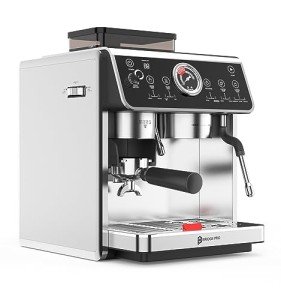20 Things That Only The Most Devoted Stainless Steel Espresso Machines Fans Know
The Art of Italian Espresso Machines: A Brewed Tradition
Italian espresso machines are not simply devices; they are an essential part of Italy's abundant coffee culture, representing a mix of artistry, engineering, and design. Coffee fanatics around the globe acknowledge the importance of high-quality espresso, a staple of Italian life and food. This post explores the history, mechanics, types, and factors to think about when buying an Italian espresso machine, showing the depth of this precious drink and its developing techniques.
History of Espresso Machines
The espresso machine's advancement go back to the early 20th century in Italy, where coffee was not simply a drink but a necessary social routine. The preliminary attempts to brew espresso started with basic, stove-top designs, gradually evolving into complicated machines that could reproduce the ideal brew.
- 1901— The First Espresso Machine: The very first steam-powered espresso machine, known as the “Ideale,” was established by Luigi Bezzera. This machinery marked a turning point in espresso developing.
- 1938— The Lever Machine: The introduction of the lever machine made it much easier to control the pressure utilized in espresso extraction, boosting flavor consistency.
- 1947— The Automatic Machine: Reaching more consumers, Gaggia introduced the very first automatic espresso machine, additional promoting espresso bars.
- 2007— The Digital Age: Technological advancements caused the birth of fully programmable machines, permitting users to customize their developing settings to accomplish a personalized coffee experience.
Secret Features of Italian Espresso Machines
Italian espresso machines embody accuracy, craftsmanship, and development. Here are some key elements that highlight their significance:
Feature
Description
Boiler Type
Determines how heat is created and preserved. Typical types include single boiler, dual boiler, and heat exchanger.
Group Heads
Where the coffee is brewed; commercial machines frequently have multiple group heads for performance.
Pressure Control
Essential for accomplishing the best espresso; most machines operate at 9 bars of pressure.
Frothing Capabilities
The steam wand allows for milk frothing, important for drinks like cappuccino and latte.
Build Quality
The materials used (stainless steel, brass, and so on) impact durability and heat retention.
Kinds Of Italian Espresso Machines
Selecting the ideal machine depends upon user preferences, budget, and planned use. Below are the main types of Italian espresso machines:
Manual Espresso Machines
- Pros: Offer complete control over the brewing process, allowing for a tailored touch.
- Cons: Require skill and practice, can be labor-intensive.
Semi-Automatic Machines
- Pros: Provide a balance in between automatic and manual procedures; users control water flow.
- Cons: Can have a steeper knowing curve than completely automatic machines.
Totally Automatic Machines
- Pros: Simplify the developing process with push-button operations; perfect for newbies.
- Cons: May compromise some of the nuances of manual brewing.
Super-Automatic Machines
- Pros: Grind, tamp, brew, and froth automatically; convenient for hectic lifestyles.
- Cons: Less control over the developing variables, potential for a less authentic espresso experience.
Purchasing Guide: Factors to Consider
Picking the ideal Italian espresso machine can be difficult, but considering the following aspects can simplify the decision-making process:
- Budget: Italian espresso machines range from affordable to high-end models, so set a budget upfront.
- Use Frequency: Evaluate how often you will use the machine; day-to-day users may want a more long lasting choice.
- Area: Measure your cooking area or counter area; some machines can be big and require enough clearance.
- Upkeep: Consider ease of cleaning; machines with removable parts or integrated cleansing functions might lower upkeep.
- User Skill Level: Beginners might choose totally or semi-automatic machines, while skilled baristas can handle manual machines.
- Brand Reputation: Research brands understood for quality, such as Breville, Gaggia, and La Marzocco.
Popular Italian Espresso Machine Brands
Italian craftsmanship is renowned for producing some of the best espresso machines worldwide. Here are top brand names worth thinking about:
- Gaggia: Known for its home espresso machines and affordability.
- La Marzocco: A superior brand understood for its commercial-grade machines and innovative technology.
- Rancilio: Renowned for its long lasting develop and professional-quality machines suitable for home and commercial use.
- Sage/Breville: Offers advanced functions and easy to use styles, best for both beginners and enthusiasts.
Frequently asked questions
What is the distinction between espresso and routine coffee?
Espresso is a concentrated coffee brewed by forcing warm water through finely-ground coffee under pressure. It has a thicker consistency, richer taste, and greater caffeine concentration than routine coffee.
Can I make milk-based beverages with an espresso machine?
Yes, lots of Italian espresso machines feature a steam wand to froth milk for beverages like coffees, lattes, and macchiatos.
How typically should I clean my espresso machine?
Regular maintenance is vital. Generally, a comprehensive cleaning is advised every few weeks, while descaling should be done every 1 to 3 months, depending on water firmness.
What is the perfect pressure for brewing espresso?
The perfect pressure for developing espresso is around 9 bars. This pressure guarantees the optimal extraction of flavors from the coffee premises.
Are more expensive machines worth the financial investment?
Higher-end machines frequently utilize better materials and innovation, providing enhanced durability and more constant results. For Office Espresso Machines , investing in an excellent machine can raise the espresso experience substantially.
Italian espresso machines are far more than mere developing gadgets; they are an event of a cultural tradition that has actually affected coffee usage worldwide. With various models offered to fit any user's needs— ranging from beginners to skilled baristas— there is an Italian espresso machine completely matched for everyone. As Energy-Efficient Espresso Machines embark on your espresso journey, understanding the history, mechanics, and alternatives will enrich your experience and appreciation for this time-honored drink. Whether you seek to recreate a café atmosphere at home or improve your developing method, these machines are capable of delivering extraordinary cups of espresso decorated with the abundant history of Italian coffee culture.
